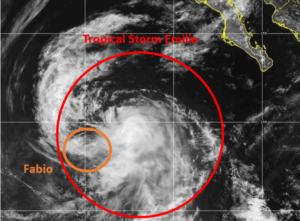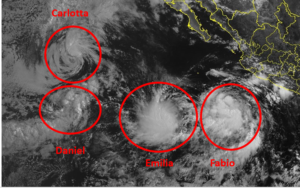Hurricane Flossie weakened rapidly on Wednesday evening as it moved over the Eastern North Pacific Ocean south of Baja California. At 11:00 p.m. EDT on Wednesday the center of Hurricane Flossie was located at latitude 19.8°N and longitude 110.2°W which put the center about 215 miles (345 km) south of Cabo San Lucas, Mexico. Flossie was moving toward the northwest at 8 m.p.h. (13 km/h). The maximum sustained wind speed was 75 m.p.h. (120 km/h) and there were wind gusts to 90 m.p.h. (145 km/h). The minimum surface pressure was 986 mb.
Hurricane Flossie was weakening rapidly on Wednesday evening as it moved over cooler water south of Baja California. Many of the thunderstorms in Flossie’s circulation were dissipating, The bands revolving around the center of Hurricane Flossie consisted primarily of showers and lower clouds. The dissipation of the thunderstorms in Flossie greatly reduced the upper level divergence. Much less mass was being pumped away from Hurricane Flossie. The continued convergence of mass in the lower levels of Flossie’s circulation caused the surface pressure to increase quickly.
The circulation around Hurricane Flossie was small. Winds to hurricane force extended out 25 miles (40 km) from the center of Flossie’s circulation. Winds to tropical storm force extended out 70 miles (110 km) from the center of Hurricane Flossie.
Hurricane Flossie will move through an environment that will be unfavorable for intensification during the next 24 hours. Flossie will move over water where where the Sea Surface Temperatures are near 23°C. It will move under the middle of an upper level ridge over Mexico and the adjacent part of the Eastern North Pacific Ocean. The upper level winds are weak near the middle of the ridge and there will be little vertical wind shear. Even though there will be little vertical wind shear, the cooler water south of Baja California will cause Hurricane Flossie to continue to weaken on Thursday.
Hurricane Flossie will move around the southwestern part of a high pressure system over Mexico. The high pressure system will steer the Flossie toward the northwest during the next 24 hours. On its anticipated track, Hurricane Flossie will remain south of Baja California.


